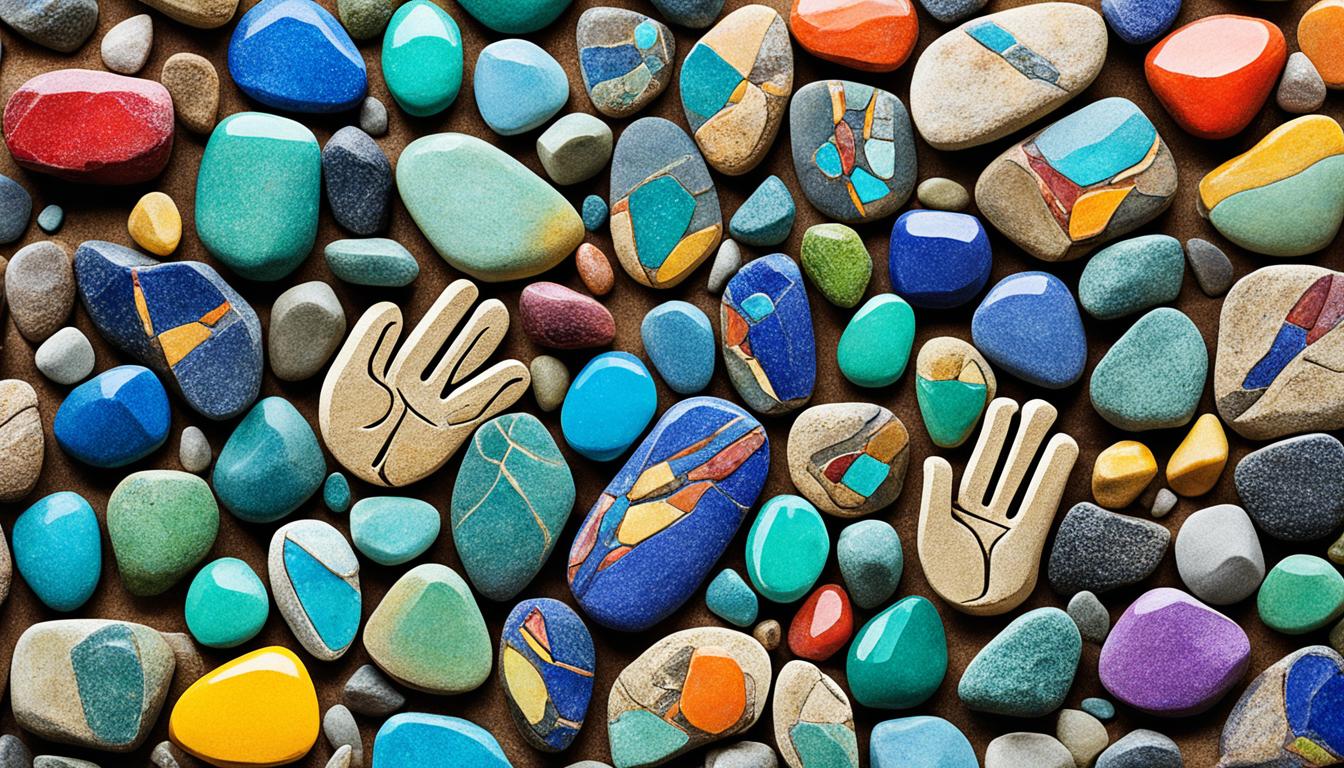This post contains affiliate links.
Within the palm of your hand lies more than just a stone; it’s a canvas awaiting transformation. With a blend of patience, skill, and creativity, gem crafts become an enthralling practice that can turn seemingly ordinary rough rocks into beautiful polished gems. The art of lapidary is not reserved for the select few; it’s a rock hobby that invites you to discover the captivating beauty locked within the crust of the Earth. Imagine holding a piece of raw history and through deliberate and caring craft, releasing the lustrous beauty of tumbled stones that speak to both the majesty and mystery of nature.
As you embark on this journey, learn to identify the potential of diverse mineral types, from the verdant allure of Amazonite to the sunset embrace of Apricot Agate. These are not just stones; they are unseen stories, untold narratives waiting eagerly for your touch. The transformation from rocky roughness to sleek splendor isn’t just about aesthetics; by uncovering these treasures, you are in essence, retracing the footsteps of time itself and sharing in the earthly creativity that is stone tumbling.
Key Takeaways
- The art of transforming rough rocks into tumbled stones can be learned and enjoyed by anyone with an interest.
- Gem crafts not only produce beautiful polished gems but also allow you to engage in an enduring rock hobby.
- Lapidary skills can be honed over time, encouraging the practice of patience and attention to detail.
- Understanding the unique properties of each type of rock will enhance your ability to create stunning tumbled stones.
- This craft mirrors the geological processes of nature, connecting you to the earth’s natural artistry.
Discover the Art of Rock Tumbling
Embark on a journey that merges the resilience of natural geology with the finesse of personal crafting; embrace the time-honored practice of rock tumbling, a methodic crusade that culminates in the creation of uniquely polished stones. This isn’t just an endeavor of aesthetic pleasure, but rather a passage to connect with the very essence of nature and an opportunity to embody an artistic vision through a tangible medium.
What is Rock Tumbling?
Imagine the gentle caress of a running stream bed smoothing pebbles over eons into mesmerizing smooth stones. Rock tumbling replicates this natural process within the containment of a mechanical device known as a rock tumbler. Through an extensive technique of polishing rocks, coarse stones transform into dazzling, lustrous gems. This captivating transformation not only fulfills the quest for beauty but also fortifies your bond with the enduring materials of Earth.
The Joy of Translating Nature into Art
There is a profound satisfaction in observing the transition from a rugged specimen to a masterpiece through tumbling stones. Each turn within the tumbler weathers away imperfections, just as the elements sculpt their magic over time in nature. While the method may seem to simply echo weathering processes, there is ingenuity involved in bringing the artistic vision to life, making the rock hobby an immersive blend of nature and creativity.
Choosing the Right Rock Tumbler
Selecting the optimal equipment is a critical step to ensure the success of your rock tumbling pursuits. The chosen rock tumbler should be congruent with the size and type of stones you aim to polish, as to guarantee the quality of the finished product—a shiny stone to reflect your dedication and patience.
| Feature | Rotary Tumblers | Vibratory Tumblers |
|---|---|---|
| Best Used For | Coarse and medium grinding phases | Pre-polishing and polishing stages |
| Processing Time | Longer; weeks per stage | Shorter; days per stage |
| Ideal For | Beginners and hobbyists | Experienced users seeking fast results |
| Rock Shape Outcome | More rounded stones | Preservation of original stone shape |
| Operational Noise Level | Low | High |
The Fascinating Journey from Amazonite to Apricot Agate
Embark on a visual and tactile voyage as we uncover the magnificence of minerals, from the soothing green allure of Amazonite to the warm, sunset shades of Apricot Agate. Each stone’s journey from a rough rock to a beautifully tumbled specimen is a testament to the artistry of the rock hobby. Discover the individual characteristics that make these stones unique and how they can transform through meticulous shaping, turning rough rocks into polished treasures.
Amazonite: The Stone of Courage
Renowned for its stunning verdant shades and association with truth and honor, Amazonite is a stunning example how turning rough rocks into polished stones can enhance their natural charm. Its serene green hues captured the hearts of crafters and aficionados alike, offering not just beauty but also a symbol of courage for those who hold it.
Angelite: A Fragile Beauty
The soft, heavenly blue of Angelite requires a gentle touch, showcasing its fragility and rarity in the rock tumbling world. Despite its tendencies to absorb color, the finished product is a fragile beauty that enchants with its tranquil shades—an ethereal addition to any collection.
Unearthing the History of Apache Tears
Apache Tears, a form of black obsidian, bears a poignant history and a depth that goes beyond its translucent quality. Originating from Arizona, these unique stones hold a captivating story, embodying a cultural richness that adds allure to each polished pebble.
The Warm Glow of Apricot Agate
With bands of apricot, pink, and cream, Apricot Agate is like a sunset captured in stone, radiating warmth and joy. Hailing from the mines of Botswana, this gemstone is particularly prized in rock tumbling for its ability to infuse any collection with a radiant, heartwarming glow.
Starting with the Basics: Preparing Your Rough Rocks
Every seasoned lapidary knows that preparing rough rocks is just as crucial as the tumbling itself. Imagine unveiling the full potential of your finds, transforming them into gleaming tumbled stones. This journey begins with basic yet powerful steps of cleaning stones and meticulously sorting rocks. Let’s immerse ourselves into this initial and essential phase, ensuring our rough treasures stand the test of tumbling.
Cleaning and Sorting Your Finds
You might be surprised to discover the difference that a good clean can make in inspecting for fractures. Begin by rinsing your collection to remove loose dirt. Then, soak your stones in a cleaning solution to dislodge any stubborn grime. A soft brush can help clean the crevices. Post-cleansing, start sorting rocks based on size and hardness; this ensures a harmonized tumbling cycle and prevents harder stones from damaging softer ones.
Inspecting for Fractures and Suitability
Imagine placing a fractured stone into the tumbler, only to find it broken into bits at the end of the cycle. To avoid such mishaps, closely inspect for fractures and cracks. Hold each rock up to the light and examine it from every angle. A magnifying glass might be helpful in spotting hairline cracks. The suitability of each stone is paramount—unsuitable rocks can disrupt the tumbling process or even damage your tumbler.
Remember, patience in preparing your rocks is an investment that pays off with perfectly polished treasures. Each stone that withstands this thorough scrutiny is destined for a transformation from rough to resplendent.
Tumbled Stones: Nature’s Hidden Wonders
Imagine the thrill of turning rough rocks, mere ordinary pieces of the earth, into tumbled stones—each a small, gleaming artifact of nature’s artistry. For enthusiasts of the rock hobby, these stones represent not just a pastime, but a genuine journey of transformation.
You have the power to unveil these earthly treasures through the meticulous process of tumbling. By polishing rocks, you reveal the vibrant colors and captivating patterns that have been hidden for millennia. It becomes apparent that the appeal of tumbled stones lies in their unique ability to tell a tale: the geological history inscribed within each one.

Patience and precision are the cornerstones as you delve into turning rough rocks into polished gems. As you embark on this craft, you’ll find that each step in your rock hobby is a step closer to discovering the wonders that polishing can bring to light. Embrace the joy that comes from discerning the latent beauty that lies beneath the surface.
Every polished stone is a letter from the deep history of our planet, and as a rock hobbyist, you are the translator tasked with revealing its message.
Contact with nature’s creative force is ever-present as you partake in the rock hobby, with each stone encapsulating a piece of the natural world’s relentless creativity. These tumbled stones are not mere trinkets—they are artifacts of the earth’s innate majesty; a reminder of its capacity for beauty in the simplest forms. Now, allow us to dive deeper into the processes that transform mundane rocks into lovely polished treasures:
- Selection: Picking the right rocks for the tumbling process is essential.
- Cleaning: Thoroughly cleaning the stones to ensure a clear surface for abrasion.
- Tumble: Using a rock tumbler, the rough edges are smoothed, and the inherent beauty of the stone begins to shine through.
- Polish: The final step in the tumbling process, where the stones gain their signature gleam.
| Rock Type | Hardness (Mohs Scale) | Ideal for Tumbling? |
|---|---|---|
| Quartz | 7 | Yes, excellent durability |
| Amethyst | 7 | Yes, provides beautiful results |
| Obsidian | 5-6 | Yes, but requires extra care due to softness |
| Fluorite | 4 | No, typically too soft |
As you delve deeper into your rock hobby, remember that each tumble unveils a hidden chapter of the Earth’s past, converting the ancient echoes of time into a tangible, polished echo of nature’s wonder. Keep these insights close as you continue the gratifying pastime of polishing rocks and creating your collection of tumbled stones.
Gemstone Cuts and Polishing Techniques
The journey to transform a simple stone into a mesmerizing piece of jewelry is steeped in the art of gemstone cuts and polishing techniques. As you delve into the fascinating world of lapidary, you’ll discover the intricate processes that elevate natural minerals to treasured gems. It’s not simply about aesthetics; it’s about appreciating the meticulous craftsmanship and ancient knowledge that continue to shape the gemstone industry today.
The Role of Lapidary in Gem Crafts
In every facet of gem crafting, the lapidary’s role is paramount. A lapidary is like a sculptor who sees the hidden beauty within unassuming rocks. Through precise gemstone cuts, they reveal the stones’ full potential. The lapidary is not just a technician but an artist, balancing the technical demands of cutting with a deep intuition for the gemstone’s innate qualities.
Exploring Faceting: From Rough to Refined
Turning a rough gem into a scintillating work of art starts with faceting. This exacting step requires a keen eye and a steady hand as each geometric plane is cut into the stone. The aim is to maximize the stone’s brilliance, allowing light to dance within its depths. Whether it’s the bold simplicity of an emerald cut or the intricate complexity of a marquise, faceting is truly where a gemstone begins to shine.
Polishing for Perfection: The Final Touch
The final step of the lapidary’s craft is polishing the rocks to perfection. Polishing not only enhances a gemstone’s shine but also removes any remaining blemishes or scratches left from the cutting process. It is a testament to the lapidary’s dedication, as this final touch can transform a gemstone into a beacon of light – a testament to nature’s beauty refined by human skill.
Whether you’re an aspiring gem crafter or simply an admirer of finely crafted jewelry, understanding these techniques enhances your appreciation for each gemstone’s journey from the earth to the showcase. So the next time you hold a beautifully faceted and polished gem, remember the finesse of faceting and the precision of polishing that brought its natural splendor to light.
Rock Polishing Materials and Accessories
As you embark on the adventure of turning rough rocks into eye-catching treasures, understanding the critical role of rock polishing materials and accessories is paramount. Lapidary, a term that represents the art of cutting and polishing stones, is both a science and a form of artistic expression. Every seasoned lapidarist knows that the journey from coarse to polish relies heavily on the quality and selection of supplies at your disposal.
Beginning with the bedrock of any polishing operation, rock tumblers are instrumental in replicating the natural smoothing processes. It’s vital to select a rock tumbler that fits your project’s scale and type of stones you’re working with. Not all tumblers are created equal; some might be better suited for small, delicate pieces, while others can handle bulk processing of larger stones.
| Material/Accessory | Purpose | Considerations |
|---|---|---|
| Tumbling Grits | Facilitate erosion and smooth surfaces | Gradation from coarse to fine for different tumbling phases |
| Polishing Compounds | Provide the final shine to the stones | Match compound to the type of stone for best results |
| Lapidary Saw | Trim and slab rough rocks before tumbling | Blade type and size to match rock hardness and size |
| Rotary vs. Vibratory Tumblers | Determines the type of tumbling action | Rotary for shaping; vibratory for faster polishing |
When assembling your toolkit, consider the grit used during the tumbling stages. Starting with a coarse grit that helps reshape the rock, and progressing to finer grits, allows you to gradually move towards the coveted smoothness. Patience is key. The process doesn’t happen overnight and requires sequential steps, each with its designated function, to ensure pristine results.
- A coarse grit for shaping and rough edge removal
- A medium grit for further smoothing surfaces
- A fine grit to prepare the stones for polishing
- A polish compound to give that final gleam
Remember, these materials and accessories effectively mimic the natural erosion and weathering process—but much faster. It’s the magic of lapidary where you learn that with the right tools and perseverance, even the most modest pebble can be turned into a glossy, attractive gem. Let your passion for rock tumblers and exquisite rock polishing materials guide you as you transform turning rough rocks into your form of art.
Turning Rough Rocks into Beautiful Tumbled Stones
The art of rock tumbling is a journey from rugged, untouched earth to smooth, polished perfection. This captivating transformation occurs in a rock tumbler—a device that emulates the relentless turn of the sea and the gentle caress of sand that shapes stones naturally over time.
The Tumbling Process Step-By-Step
Commence with selecting your rough rocks, choosing those with potential to unfold into blossoming tumbled stones. Your first encounter with the rock tumbling process will be to place these candidates into the barrel of your rock tumbler, ready for their first revolution.
- Clean your rocks thoroughly to ensure a grit-free start.
- Check for compatibility—softer stones may not withstand the tumbling process next to harder varieties.
- Begin with coarse grit to shape and smooth the stones’ rough edges.
- Progress through finer grit stages, meticulously refining the surface.
- Complete the process with a polish stage, bestowing a gleaming sheen to your newly formed treasures.
Time, Grit, and Patience: Secrets of Tumbling
It is with the potent combination of time, grit, and patience that your rough rocks will be reborn as enviable tumbled stones. Much like nature takes its due course to form ocean-polished pebbles, so must you allow the tumbler to work its magic—to replace the jarring edges of yesterday’s rocks with the luminescent curves of tomorrow’s gems.
| Stage | Function | Grit Size | Duration |
|---|---|---|---|
| 1. Initial Grind | Shaping/Stress Relief | 60-90 | 1 Week |
| 2. Medium Grind | Smoothing | 120-220 | 1 Week |
| 3. Fine Grind | Pre-Polish | 500 | 1 Week |
| 4. Polish | Polishing | Tin Oxide/Alumina | 1 Week |
Remember, as you embark on this transformative process of turning rough rocks into tumbled stones, let the smooth rhythm of the tumbler remind you of the seamless dance between nature and artifice—a dance where you are the choreographer guiding the raw through the tumbling process to reveal the splendor within.
The Emotional Reward of Tumbled Gemstones
When you journey through the process of transforming coarse rocks into tumbled stones, you’re engaging in more than just a simple rock hobby; you’re initiating a deep, emotional passage. The cycle from the rugged to the refined manifests an emotional reward that is as polished as the stones themselves. Let’s delve into how this craft transcends physical labor and touches the lapidary’s soul.

The alchemy of taking raw minerals and methodically working them into captivating tumbled stones is a testament to your patience and dedication. Unlike many hobbies, lapidary arts offer a distinctive combination of tactile satisfaction and visual splendor. Each completed stone is not just an object of beauty but a marker of personal growth, reflecting the passage of time and persistence in its smooth, glassy surface.
Your hands shape the stones, but in turn, the stones shape something within you, nurturing a serene state of mind and a feeling of accomplishment.
The presence of gleaming gems on your palm does more than just spark joy; they act as a bridge to your inner self, an intimate dialogue with creativity and nature. Picture yourself in a quiet room, the hum of the tumbler in the background, knowing that with each revolution, you’re a step closer to uncovering a treasure that previously lay hidden in plain sight.
- The Joy of Creation: Starting with a nondescript stone and ending with a lustrous gem makes you the alchemist of your own joy.
- Sense of Achievement: Each tumbled stone is a monument to your perseverance and a stepping stone to mastering your craft.
- Peaceful Meditation: The repetitive process of sorting and polishing can be meditative, offering you a tranquil retreat from the rush of everyday life.
This journey through the rock tumbling process and its result in exquisitely tumbled stones represents a rich, emotional experience that defines the very essence of this rewarding hobby.
The Healing Power of Tumbled Stones
As you delve deeper into the world of tumbled stones, you discover an echo of nature’s serenity in the palm of your hand. These polished gems aren’t just pleasing to the eye; they carry an essence of tranquility and restoration that many believe can support healing and wellbeing. Let’s explore the healing attributes of some remarkable stones.
Banded Amethyst: A Stone of Peace and Healing
The Banded Amethyst is a stunning tumbled stone, revered not just for its striking appearance but also for its capacity to promote peace. Known for its gentle waves of purple and white, Banded Amethyst is said to create a sense of calm and is believed to aid in healing both the mind and body, making it a cherished addition to any collection.
Bloodstone: Revitalization and Purification
Named for its distinctive red splashes that evoke drops of blood, the Bloodstone is said to harbor powerful revitalizing energy. This vibrant green jasper is believed to purify the body and instill courage, nurturing your spirit as it captivates your senses.
Chrysocolla: Communication and Calmness
With its soothing blue-green hues, Chrysocolla is a stone of communication and calmness. Often found nestled within quartz, this mineral is believed to empower both expression and silence, providing the space for inner peace to flourish in your life.
Whether displayed as ornate decorations or worn as personal tokens, these tumbled stones weave together beauty and mystique, creating a tapestry of healing powers that is both ancient and forever new. Discover the sense of balance and restoration they may offer as you embrace the healing power of tumbled stones in your daily journey.
Conclusion
The process of turning rough rocks into beautiful tumbled stones is akin to uncovering a hidden narrative etched deep within the earth. It’s a unique blend of geological expertise and artistry that leads to the creation of mesmerizing tumbled stones. At the outset, it may seem like a simple task of polishing, but as you delve deeper into the world of gem crafts, you recognize the nuanced symphony of techniques and patience required to reach the crescendo: a perfectly smooth and lustrous gem.
Each tumble you undertake is not just a mechanical action; it’s a step towards mastering the intricate art of rock polishing. Every stone you transform tells its own geological saga, from the pressures it endured deep within the Earth to its final form, caressed and coaxed into beauty by your hands. For many, these stones carry more than just physical allure; they resonate with energies believed to bring healing and peace, marrying aesthetics with wellness.
As you continue on your journey, the craft of shaping rough edges into polished marvels is not only a nod to the rhythms of nature, but also an anthem celebrating your capacity to unleash the potential of each stone. Embrace the satisfaction that comes from gem crafts—a rich hobby that envelops both heart and mind, rewarding your diligence with tangible, radiant expressions of nature’s art. Let the allure of discovering nature’s hidden wonders continue to inspire you in your quest for the next gleaming treasure.
FAQ
What is rock tumbling?
How does one choose the right rock tumbler?
What are the first steps in preparing rough rocks for tumbling?
What is the role of a lapidary in gem crafts?
What materials are needed for rock polishing?
Can you describe the step-by-step tumbling process?
What are the secrets to successful rock tumbling?
What healing properties do tumbled stones like Banded Amethyst, Bloodstone, and Chrysocolla hold?
Source Links
- https://rocktumbler.com/polished-stones/
- https://gemologue.com/designers/everything-you-need-to-know-about-gemstone-cutting-for-beginners/
- https://folkmarketgems.com/
This post contains affiliate links.


[…] gemstone jewelry. This rewarding DIY guide is designed to assist you in navigating the nuances of rock polishing for jewelry making, uncovering the simple pleasures of shaping natural elements with your hands. Whether you’re […]